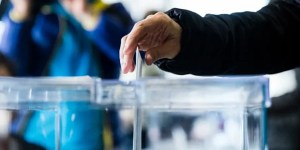By Michael Dimock

As some poll watchers have observed, Pew Research Center has shifted its approach for the 2016 election cycle, focusing on fewer, larger political surveys, new work with our American Trends Panel and a continued emphasis on larger themes related to political polarization, partisan antipathy, distrust and compromise. We’ve been getting questions about what people can expect to see from Pew Research Center in the final weeks before Election Day. Compared with past years, our October and November plans have changed significantly in that the Center will not be producing likely-voter estimates of the state of the race or making a final projection of the national vote total.
Why the change in strategy? As we developed our research plan for 2016, we put a lot of thought into how the Center might make unique contributions to understanding the forces and dynamics underlying the election. This approach was shaped by a sense that our mission – to enrich the public dialogue and support sound decision-making – should push us toward addressing questions that others are not asking, at a depth that others may not have the resources to investigate. It is also a recognition that the field of pre-election “horse-race” polling has become increasingly crowded, including by organizations rightfully putting a focus on polling in key battleground states. Putting resources toward an already saturated market doesn’t make much sense for us. And making the commitment to produce high-quality projections of the election was taking us away from where we thought we could innovate and illuminate. So we set out to design our work differently this year.
This does not mean Pew Research Center is going dark when it comes to political coverage. We have a number of election-related research projects in the pipeline, including a major national survey of more than 2,000 Americans that will examine views of the candidates, campaign and key issues, with a focus on the attitudes of Clinton and Trump supporters. We also have forthcoming research on the tone and climate of political discussions on social media as well as on Latino voters’ issue priorities and preferences. Some of this work is picking up on trends the Center established over the decades, to put the 2016 election into context and understand what is and is not unique about this election. Some of this work is new, focusing on new data opportunities and lines of questioning, with an eye toward better understanding the consequences of the election and what it means for the political landscape beyond Nov. 8.
There are downsides to any decision. This one limits the extent to which readers, and the polling community more generally, can use our surveys to project who will win this year’s election. The number of survey aggregators now giving the public a general sense of how the race is ebbing or flowing, however, makes this less of a loss. Our decision also takes away an opportunity for us to test our survey accuracy against an objective external reality: the national vote total. However, elections are only one way – and not necessarily the best way – to gauge polling accuracy. We are doubling down on other research investments to compare our methodologies, and those of others, against known benchmarks. Our long-standing work to confirm the accuracy of public opinion polls and identify best practices for the field will continue.
Perhaps most importantly, this does not mean we believe that polling is no longer accurate enough to be used to predict election results. To the contrary, the record of the field is a strong one, and there are all sorts of innovations in data collection going on that have the potential to further increase that accuracy. People tend to remember the polling failures, but there have been far more successes, whether in the 2016 primaries or in previous midterm or general elections. This isn’t a methodological decision for the Center. It’s a matter of research focus. We’ll be watching the final weeks of this election as closely as anyone – we’ll simply be putting our energy where we feel we can do the most to further public understanding of the attitudes and dynamics shaping the 2016 election and where the United States goes next.
Michael Dimock is president of Pew Research Center





